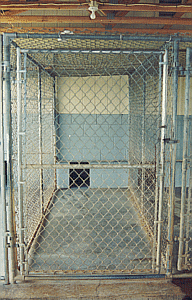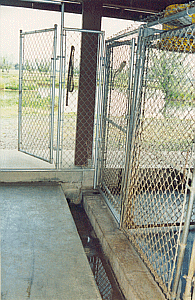Build A Backyard Kennel

4' x 10' run with dog houseinside building. Sealed concrete block forms the back of the kennel.
 Construct a concrete gutter to allow waste to run into the septic or sewer. It should be deep enough to prevent solids from splashing out when hosing down the run.
Construct a concrete gutter to allow waste to run into the septic or sewer. It should be deep enough to prevent solids from splashing out when hosing down the run.
by Debra Folsom
California Waterfowl Magazine - Aug/Sep 1995
Every retriever owner should have a kennel. A well built, kennel is the only safe place for your dog, when you're not around to supervise his activities. Most retrievers are fairly destructive and can make short work of ruining landscaping, sprinkler systems, decks etc. When a dog chews things up that are not meant to be edible, they can become lodged in the intestine and actually kill the animal.
The saying, "absence makes the heart grow fonder" is true with a retriever. A dog that is in a kennel all day, will be happier to see you when you return, and more eager to learn when it's time for his training session. If the dog is to have time in the house, save it for after his training or exercise session, then return him to his kennel for the night. A hunting retriever should spend the nights outside. This will help him develop the cold, water coat that he will need for duck hunting. It doesn't make sense to let the dog sleep in the warm house, and then expect him to swim in the cold water after a duck. The cold nights will help him develop the thick coat, and extra fat insulation he needs for cold water hunting.
The best floor surface for a kennel is concrete. It takes little or no maintenance and is impervious to urine, and parasites. We have little or no problem with fleas, when the dogs are housed on concrete runs. Gravel, or dirt runs cannot be sanitized and dogs can dig their way out under the fencing. Plywood floor runs are satisfactory, but the plywood will need to be repainted annually, to keep it as moisture resistant as possible. Pour the concrete floor with a slope to allow the water to run off when you hose out the run. You will need a gutter or trough at the low end to catch the water, and direct it away from the kennel. If you don't construct a gutter, it will always be wet, with a resulting urine odor around the kennel. Ideally you can run the wash water, and dog waste down the gutter, into your sewer, or septic. If not, you will need to scoop up the solids and run the wash water ten, to fifteen feet away from the kennel. You can accomplish this with a 4" round piece of PVC pipe.
Most people think a large dog should have a large run. A standard dog run is 4 feet wide, by 10 feet long, by 6 feet high. This is perfect for a retriever. The dog's kennel run is not a place for him to exercise or run. He'll do that when you get home and take him out for his retrieving session. The dog spends 95% of his time in his run, sleeping. The fencing should be heavy, nine gauge, chain link.
Lighter wire will stretch and bend. The most determined dogs can actually chew eleven gauge wire. It is best to put a wire top on the run to prevent dogs from climbing out or climbing in, if you should happen to have a bitch in season. Most fence companies sell pre-fabricated dog runs or you can have them custom built to your specifications. The chain link panels simply bolt together. You will not need to fasten the run to the concrete. A free standing run will usually stay anchored unless your dog is unusually large. There are special dog run gate latches available that humans can open, and dogs cannot. There is the odd dog that can operate these special, dog proof, latches. You will need a second, locking latch if this is the case.
In California, it is best to locate your dog run with a northern, or eastern exposure. If the run is located on the west, or south side of a building, it will be too hot for the dog. In our state, shade is a necessity. Retrievers can withstand the cold, but not the heat. A waterproof top or roof is a plus, and can eliminate the need for a dog house altogether, if the run is sufficiently protected from the weather, and prevailing wind. Shade cloth, such as they use in nurseries, is ideal to provide shade since the air can pass through it, but the sun's rays are filtered.
I like to locate the dog house outside the run, and have the rear chain link panel, built with a doggy door, size, hole to allow the dog to go into the house. This arrangement makes it very difficult for the dog to chew up the house. It also gives the dog more room inside the run. You can position the run up against the side of a garage, or building. In this case, you would not necessarily need a rear, chain link, panel. Simply fasten the two side panels to the building. A rear chain link panel, flush against the building, will however prevent the dog from chewing the siding on the building. Cut a hole for the dog to enter the building and construct the dog house inside the building. The dog house will not need a door, as it will get too moist inside. We don't have the extreme cold in California that would require a closed entrance, and the dogs seem to prefer to be able to look out and enjoy the fresh air. The most practical material for the dog house is 5/8" plywood. It is very durable and if the house is located outside the run, it is difficult for the dog to chew it up from the inside, as the exposed edges are minimal. The commercially made, igloo shaped dog houses or "Dogloos" work very well placed inside the run.
I can't really recommend a dog bed. Most retrievers have little or no appreciation of them, and they are all edible. Straw creates a great habitat for parasites. In our climate, probably no bed is best. At our kennel only the old timers have a bed. I have met few young retrievers that had any appreciation of a soft bed. If a dog eats a mat or rug, the strings can get tangled in the intestine and saw through the intestinal wall, killing the dog.
A retriever will need at least a three gallon bucket for a 24 hour supply of water. There are automatic watering devices available. "Lixit" makes a device that attaches to a water faucet or garden hose. They are available through most pet stores and dog supply catalogs. Some dogs will play with these until they break, and get water all over, in the process. We use the plastic, 5 gallon buckets that are used commercially for paint, chemicals, and foods. You can sometimes pick these up used, very reasonably.
A well constructed kennel is a worthwhile investment. It will give you piece of mind, knowing that your retriever is comfortable, and safe, during the long periods you must leave him alone.